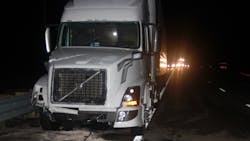More anti-collision tech needed, NTSB says in drug-tinged illegal operation crash
In a release issued Wednesday afternoon, the National Transportation Safety Board (NTSB) reiterated its calls to implement vehicle collision-avoidance technology such as autonomous emergency braking more widely after investigating a 2016 heavy truck-SUV crash with significant — and disturbing — operator factors involved.
The collision "illustrates the need to implement 15 safety recommendations associated with the NTSB's Most Wanted List of transportation safety improvements for fatigue, occupant protection and collision avoidance," the agency stated in its release.
"Survivors of the crash said they believed the SUV was traveling near the posted minimum speed limit of 40 mph while the striking semitractor-trailer was traveling near the posted maximum speed limit of 75 mph at the time of impact," NTSB noted further.
"The causal and contributing factors to this tragic and completely preventable crash demonstrate why the issues of fatigue, occupant protection and collision avoidance are on the NTSB's Most Wanted List of transportation safety improvements," stated Rob Malloy, director of NTSB's Office of Highway Safety.
In its release, however, NTSB left out a number of those potential "causal and contributing factors" investigators found.
The crash
In this macabre collision, a 2004 Toyota Sequoia SUV, designed for an occupancy of seven passengers but at the time carrying 11, was determined to have likely been traveling at around 40 mph on Interstate 70 in Goodland, KS. That was never confirmed, since no data could be recovered from the vehicle. The highway has a speed limit of 75 mph and a minimum speed of 40 mph.
The collision happened at about 2:15 a.m. the morning of June 29, 2016. A model year 2016 Volvo VNL 670 traveling at the 75-mph limit ran up on the SUV and rear-ended it, causing some damage to the front of the Volvo and sending the Sequoia into a roll off the road that would leave six passengers dead.
"The SUV was traveling at a slower speed than the truck, which overtook the SUV and rear-ended it," NTSB's accident brief summarized. "The truck driver told investigators that, to avoid an imminent collision with the SUV, he took evasive action by applying the brakes and steering to the left. Roadway mark evidence supports that he did take such action when he was about 100 ft. away from the SUV."
The Volvo truck's electronic control module data confirmed it was traveling at the 75 mph limit when the collision occurred, according to NTSB's report.
Human factors
While NTSB called for more technology to help prevent this sort of collision and loss of life, there are also many striking aspects relating to the collision in this investigation's report of the human factors involved — and some that suggest it never should have happened the way it did, or certainly didn't need to.
The driver of the Volvo truck had come from Sacramento, CA a total of 1,362.9 miles over the two days before it occurred, according to trip data and fuel receipts from the truck. The truck driver was 27 years old and had a valid Class A commercial driver's license issued by California with endorsements for "double-triples, combination tank, hazardous materials and motorcycles," NTSB reported.
He'd been driving commercial motor vehicles for three years and was on only his second trip for his employer at the time the fatal crash took place. Including the carrier he was with at the time, the driver had been employed by seven motor carriers in his three years with a CDL. He passed a roadway skills check with his latest employer prior to the crash without issue. In a medical exam he passed three months before the crash, the driver was rated at 20/20 uncorrected vision and normal hearing, the NTSB investigators found.
The truck driver said he hadn't used alcohol or drugs on or before the trip, and his toxicology screening confirmed that. However, "an examination of the truck driver's logbook revealed that over half of the entries had been falsified," according to the investigation report, and the driver kept two sets of logs "to hide his violation of the regulations."
That was, in part, because the driver was determined to have also been hauling for Lugg.com, an "Uber-type" employer, as NTSB assessed it, and worked 40 hours in that job in the run-up to the ill-fated Volvo truck run that got as far as Kansas. "The truck driver acknowledged that he did not include his secondary employment in his calculations of his hours of service prior to beginning the crash trip," the investigation report stated.
The truck driver used his cell phone while the truck was in motion, but not at or near the time of the accident, NTSB investigators found after examining his call and text records.
The truck driver told police and NTSB investigators he'd set the cruise control at 68 mph and left the headlights on low beams due to oncoming traffic. The pavement was wet from rain that had stopped, in the driver's estimation, about an hour before the collision. After the Volvo crashed into the Toyota, the driver said he called 911 "immediately," NTSB reported.
The truck driver told a Kansas state trooper who arrived at the accident scene "that the Toyota was in the middle of the right travel lane with no lights on" and that the SUV had been "either stopped, extremely slow, or near stopped." Though they searched, the responding officers reported they couldn't find the Toyota's taillights in the crash.
A ghost
None of the survivors from the Toyota said they'd looked at or seen the vehicle's speedometer, but guessed that the vehicle was traveling at about 35 to 45 mph.
The SUV's driver, 22, "reportedly was an undocumented person in the United States" and had no U.S. driver's license, according to the NTSB investigators. The agency also noted it is unaware of the driver's possession of an actual driver's license in his country of origin.
"During his admission [to the hospital], he screened positive for methamphetamines and cocaine, but confirmatory testing was not performed," the NTSB report stated. Further, he disappeared: the driver "fled the hospital in Wichita, KS prior to being interviewed" and "several attempts were made to locate and interview the driver without success."
This driver had been hired to transport a group of undocumented immigrants from Houston, TX to "various locations in the southwestern United States," according to the NTSB report, and "was actively engaged in this employment at the time of the crash."
The driver had picked up passengers in Houston at around 10 p.m. on June 27, investigators determined, a little more than a day before the crash. The SUV's second-row seat was designed for three passengers but had four in it, the third-row seat was designed for two but had three, and the rear cargo area had another two individuals, NTSB investigators reported. Only the driver and front passenger were wearing seat belts.
The Sequoia was having problems, the surviving occupants told police. They said that prior to the crash, the driver had made only brief stops so the passengers could get food and use the restroom, the report stated. One survivor told an officer the Toyota's engine was losing power before the collision and speculated that the driver had mistakenly put diesel fuel in the vehicle's tank at one of the stops.
The issue apparently kept the Toyota to low speeds on the highway, but the driver didn't turn on the hazard signals to alert others on the road that something was wrong. "In addition to the decrease in power, there was an uncharacteristic metallic sound coming from underneath the vehicle," NTSB investigators also noted from the survivors' accounts.
One of the survivors told police he heard the driver notify his employer of what was happening with the SUV "and overheard the driver being instructed to solve the problem while en route."
When the overloaded SUV was hit from behind and with the lack of seat belt use, "five passengers from the Toyota were ejected and one was partially ejected," according to the NTSB investigators. After the crash, their report noted, the Toyota was determined to have been traveling in the opposite direction of the group's next intended destination of Denver, where one passenger was headed. The rest of the passengers were to be dropped off in Los Angeles.
An investigation of the crash by the Kansas Highway Patrol is ongoing.




